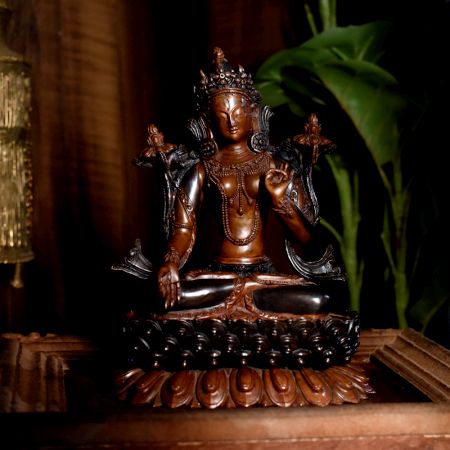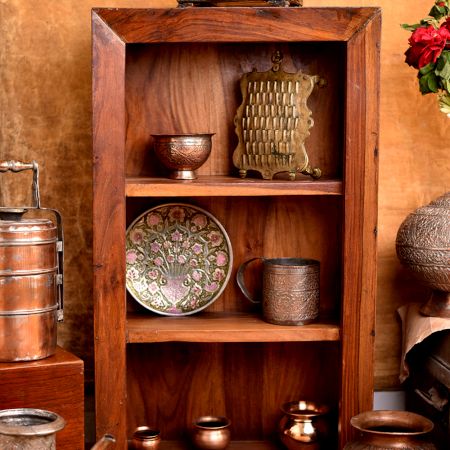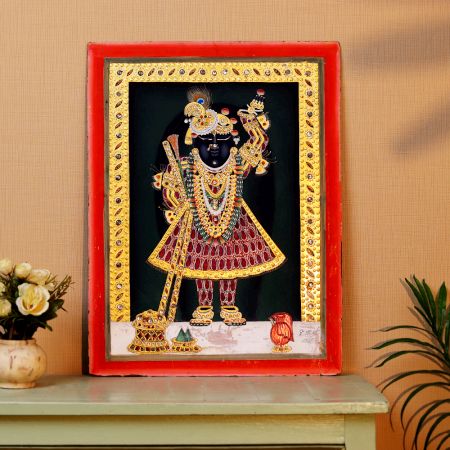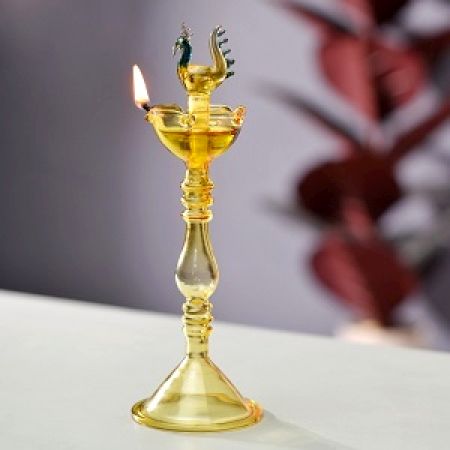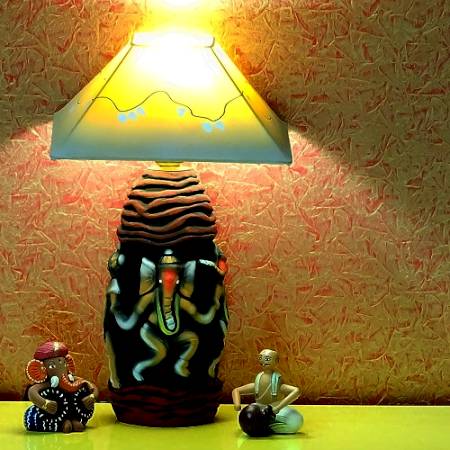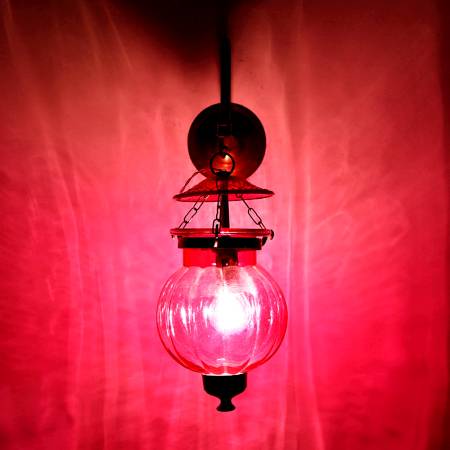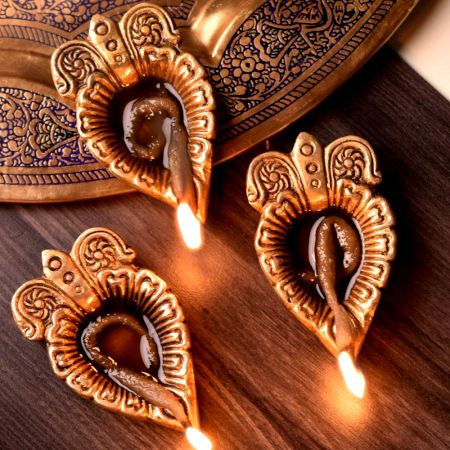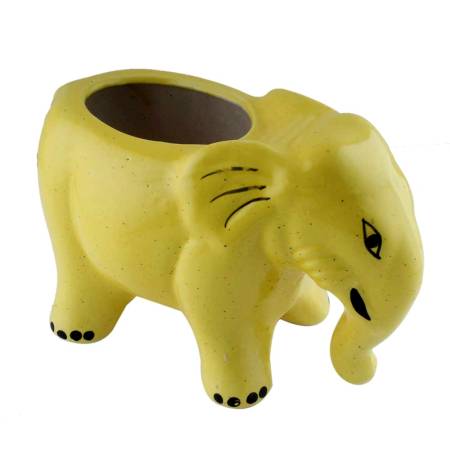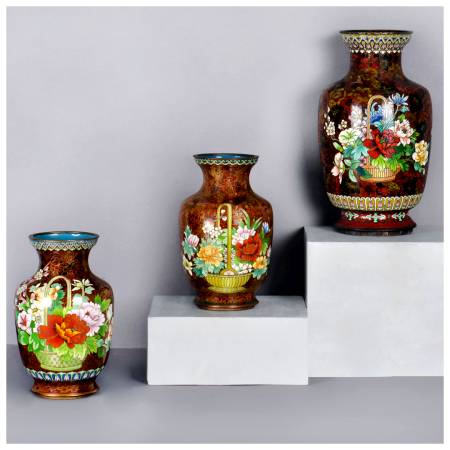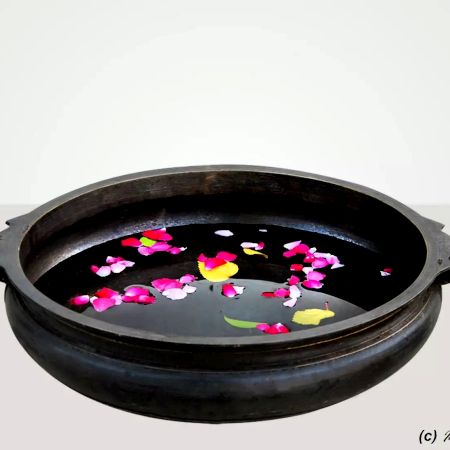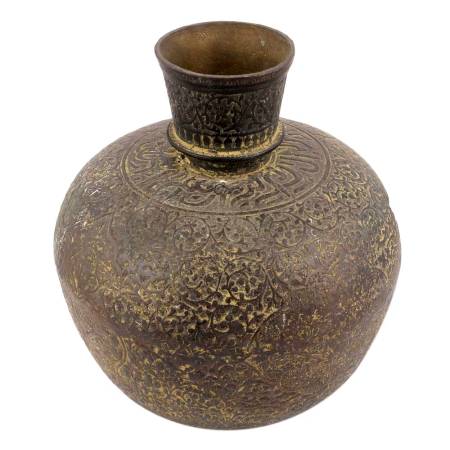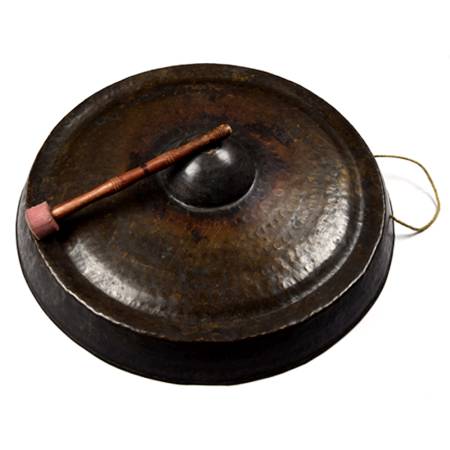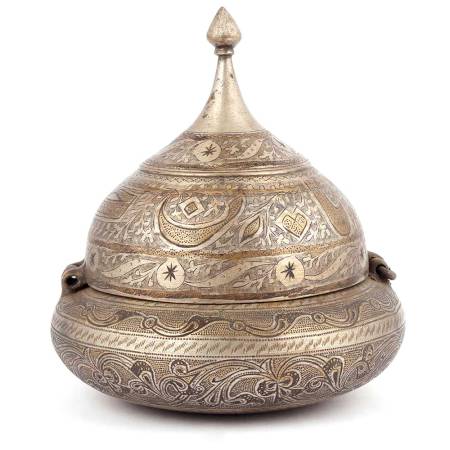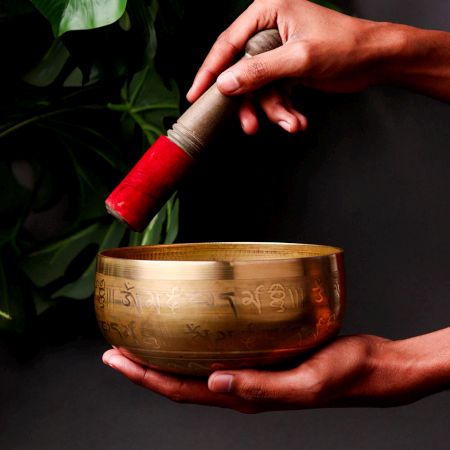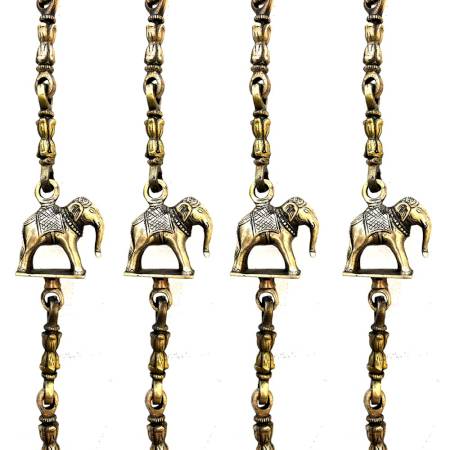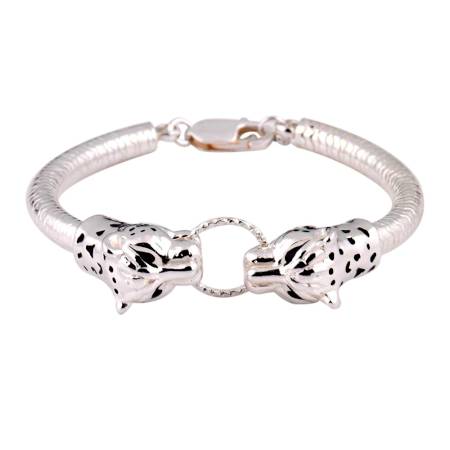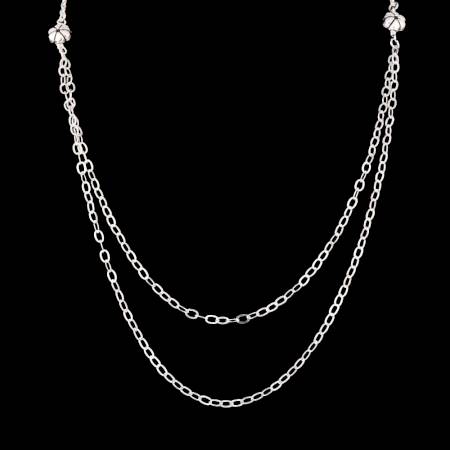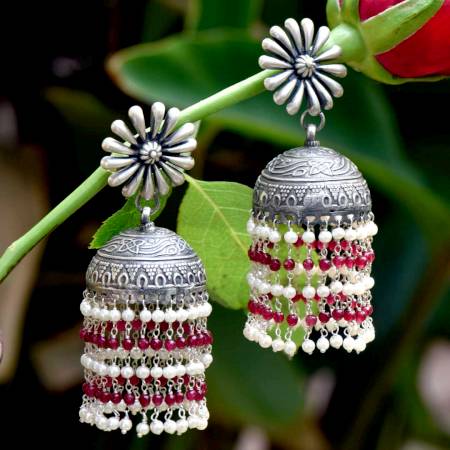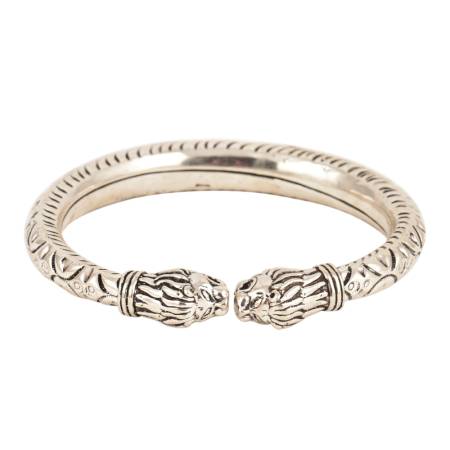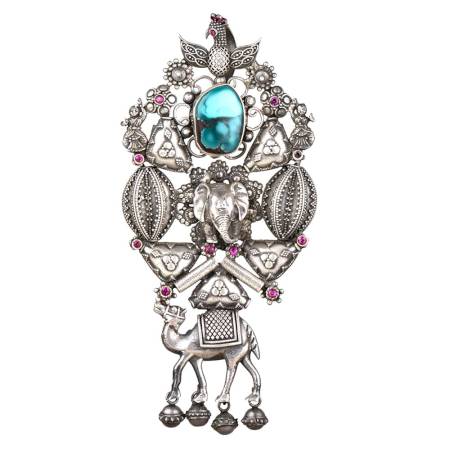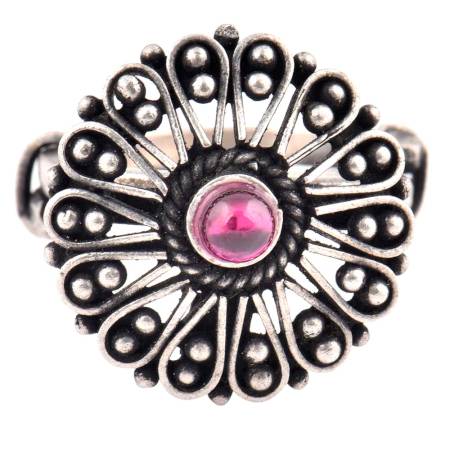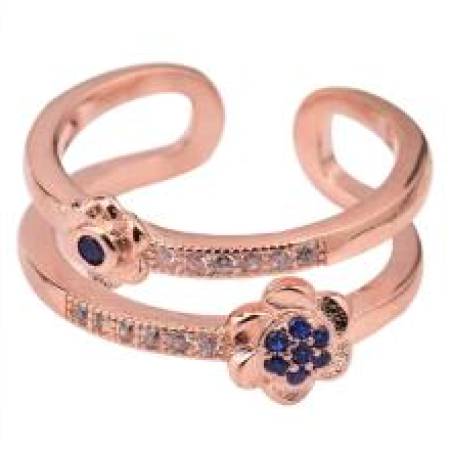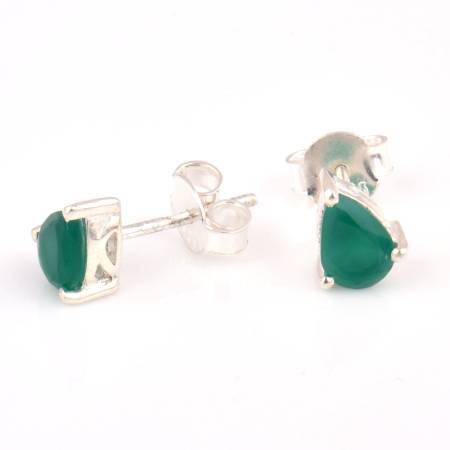Vintage Italian Style Brass Enameled Chandelier with Clear Glass Teardrops
-
₹ 12,560.00
₹ 15,700.00 -
Only a few left
Vintage Italian Style Brass Enameled Chandelier with Clear Garland Strands - 1.5 cm D...
-
₹ 12,560.00
₹ 15,700.00 -
Only a few left
Vintage Italian Style Brass Enameled Chandelier with Clear Garland Strands - 2 cm Dro...
-
₹ 12,560.00
₹ 15,700.00 -
Only a few left
Vintage Italian Style Brass Enameled Chandelier with Clear Garland Strands - 3 cm Dro...
-
₹ 12,560.00
₹ 15,700.00 -
Only a few left
Vintage Italian Style Brass Enameled Chandelier with Twisted Icicles Crystal Drops
-
₹ 12,560.00
₹ 15,700.00 -
Only a few left
Vintage Italian Style Brass Enameled Chandelier with Faceted Diamond Crystal Drops
-
₹ 12,560.00
₹ 15,700.00 -
Only a few left
Vintage Italian Style Brass Enameled Chandelier with Octagonal Crystal Drops
-
₹ 12,560.00
₹ 15,700.00 -
Only a few left
Handcrafted Vintage Design Brass Chandelier With 44 Clear Glass Maple Leaf
-
₹ 12,320.00
₹ 15,400.00 -
Only 1 left
Handcrafted Vintage Design Brass Chandelier With 44 Clear Glass Prism Drop
-
₹ 12,320.00
₹ 15,400.00 -
Only 1 left
Handcrafted Vintage Design Brass Chandelier With 44 Clear Glass Tear Drop
-
₹ 12,320.00
₹ 15,400.00 -
Only a few left
Handcrafted Vintage Design Brass Chandelier With 6 Clear Frosted Glass Lamps
- ₹ 85,000.00
-
Only 1 left
Spatial Illumination with Ceiling Lamps and Chandeliers
General Understanding of Ceiling Lamps
Ceiling lamps are not just fixtures above our heads, they are the quiet anchors of a room. They command presence without shouting, casting light that defines the mood, the pace, the silence, and even the conversations within the space. Unlike décor pieces that rest on shelves or corners, ceiling lamps hang as silent orchestrators. They bridge the gap between functionality and artistry, where their glow does more than illuminate, it shapes memory, intimacy, and perception. From grand chandeliers to humble flush mounts, they continue to be the poetry of interiors, stitched above our daily lives.
What Is a Ceiling Lamp?
A ceiling lamp is a mounted source of light, suspended or fixed, designed to illuminate interiors from above. But beyond definition, it becomes the heart of visibility in a room. It ensures that people gather under one sphere of glow, where tasks, dinners, and quiet reflections happen. Unlike floor or table lamps, ceiling lamps distribute light across wide spaces evenly, making them a foundation of practical design. Whether ornate or minimalist, they are built to merge utility with style. A ceiling lamp is therefore not only a fixture, it is a narrative of light that flows from the ceiling into everyday human interaction.
What Emotions or Atmospheres Do Ceiling Lamps Commonly Create in Interiors?
Ceiling lamps carry the power to dictate atmosphere. A soft pendant lamp above a dining table can create intimacy, where conversations slow down and laughter feels warmer. A grand chandelier in a hall introduces awe, almost ceremonial in tone, commanding respect as people walk beneath it. A flush mount lamp, subtle and unobtrusive, often brings comfort, evoking safety and familiarity in daily routines. The interplay of brightness, shadow, and direction turns the lamp into an architect of mood. It reminds us that emotions do not just come from people, they often stem from how a room chooses to hold its light.
What Are the Most Recognized Styles of Ceiling Lamps (e.g., chandeliers, pendant, flush mount)?
Ceiling lamps appear in distinct styles, each carrying its personality. Chandeliers, often cascading with layers, belong to opulence, reflecting grandeur and formality. Pendant lamps, hanging singularly or in clusters, are versatile storytellers, they can feel casual over a kitchen counter or dramatic in a living room. Flush mount lamps, closer to the ceiling, embody simplicity, often reserved for bedrooms, hallways, or spaces where elegance rests in restraint. Semi-flush mounts bridge formality and ease, while recessed lighting speaks the language of modern minimalism. Together, these styles are not just categories of design, they are choices of character, marking how spaces want to be remembered.
Why Are Ceiling Lamps Still Central to Contemporary Home Design?
Ceiling lamps remain central because they answer two needs at once, the need for clarity and the need for beauty. In homes, they are often the first layer of light, setting the foundation for additional moods created by table or wall lamps. Without them, a room feels incomplete, as if missing its crown. Contemporary design celebrates ceiling lamps not only for their illumination but also for their ability to function as sculptural art. A ceiling lamp is therefore indispensable, it ties together furniture, color, and texture, ensuring that design feels cohesive. It becomes less of an accessory and more of a necessity.
Evolution, Innovation & Design Trends of Ceiling Lamps
Ceiling lamps carry the arc of time. From oil lit lanterns and crystal chandeliers to sleek LED modules and smart enabled systems, they have shifted with human progress. Their designs mirror cultural aspirations, vintage lamps celebrated ornamentation, while modern ones reflect clean lines and efficiency. What has not changed is their central role in shaping visibility and atmosphere. Today, the ceiling lamp is more than an object of lighting, it is a design statement, a technological marvel, and sometimes even a voice controlled companion. The journey of ceiling lamps is not just about style, it is about adaptation to the way we choose to live.
How Have Ceiling Lamp Designs Evolved From Vintage to Modern Times?
The journey of ceiling lamps is layered with both function and taste. Vintage lamps, especially chandeliers, were designed as statements of wealth and stature, often adorned with crystals and metals that refracted candlelight into scattered brilliance. With electricity, they transformed into fixtures of power, democratized in homes through simpler flush mounts and pendants. Modern times shifted focus to minimalism, where clean shapes, geometric forms, and efficiency replaced heavy ornamentation. Today, lamps are crafted to merge with architecture rather than dominate it, allowing light itself to become the design. Evolution here is not just about aesthetics but also about accessibility and adaptability.
What Role Has Technology Played in Shaping Ceiling Lamps (LEDs, smart lighting)?
Technology has completely redrawn the map of ceiling lamps. LEDs introduced efficiency and longevity, giving designers the freedom to explore thinner, more intricate forms that traditional bulbs could not support. Smart lighting elevated them further, suddenly, lamps could be dimmed, colored, or voice controlled to match mood and occasion. In offices, tunable lamps simulate natural daylight to improve productivity. In homes, they shift between warm tones for dinner and bright whites for work. Technology allowed ceiling lamps to cross the boundary from static fixtures to dynamic systems that interact with human rhythm. The lamp no longer just lights, it communicates.
What Are the Current Design Trends in Ceiling Lamps Across Homes and Offices?
Design trends today are both aesthetic and functional. In homes, pendants crafted from natural materials like bamboo, rattan, and brass are in demand, tying design back to nature. Minimalist flush mounts with sleek LED panels dominate apartments where space is limited. In offices, modular ceiling lamps with tunable settings respond to changing tasks, reducing strain and enhancing focus. Smart integrated fixtures are now common, aligning with sustainable design goals. Across both homes and offices, trends lean toward adaptability, lamps that can shift mood, save energy, and blend effortlessly with architecture. The modern ceiling lamp is therefore not static, but responsive.
Design Intent and Lighting Storytelling of Ceiling Lamps
Ceiling lamps do not just exist, they narrate. Their placement, shape, and glow tell stories about how a space wants to be lived in. They may whisper intimacy in soft golden hues or announce grandeur with brilliance that dazzles. Through them, designers capture culture, memory, and aspiration. The lamp becomes a bridge between light and life. Storytelling in ceiling lamps lies not in words but in shadows, in the way brightness falls on a dining table or how corners remain dim. They turn interiors into experiences, reminding us that design is not decoration, it is dialogue.
What Stories or Themes Do Ceiling Lamps Aim to Convey Through Their Design?
Every ceiling lamp tells a story. A chandelier conveys elegance and occasion, reflecting tradition and continuity. A rustic pendant may narrate the story of craftsmanship, of hands that worked with metal or wood to shape beauty. Minimalist lamps often echo themes of clarity and calm, projecting values of modern living. The stories are rarely loud, but they live in subtleties, the choice of shape, material, and brightness. They speak about the identity of a space and the aspirations of those who live there. In this way, ceiling lamps become both storytellers and silent biographers of human interiors.
How Do Designers Express Cultural, Vintage, or Modern Inspirations in Ceiling Lamps?
Designers weave cultural memory into ceiling lamps through motifs, materials, and forms. A vintage inspired chandelier might revive the ornamentation of palaces, while a modern pendant lamp strips design down to pure geometry. Cultural inspirations arrive through patterns, Moroccan lattice, Indian brass carving, Japanese minimalism, all infused into contemporary formats. In offices, designers lean toward sleek modular structures, emphasizing efficiency and technology. In homes, vintage brass or retro glass reappears to root interiors in nostalgia. The ceiling lamp therefore acts as a flexible canvas where designers express identity, whether honoring heritage or aligning with global modernity.
How Do Light, Shadow, and Bulb Choices Influence the Ambience of Ceiling Lamps?
Light and shadow are the true language of ceiling lamps. A warm toned bulb creates intimacy, while a cool white opens up a sense of alertness. Shadows falling from pendant shades can produce patterns on walls, turning rooms into textured canvases. Brightness levels dictate function, bright for tasks, soft for relaxation. The choice of bulb, LED, halogen, or smart controlled, extends the narrative, making lamps adaptable to different needs. Designers often play with diffusion, ensuring that light is not just seen but felt, wrapping the room in a mood. Through bulb and shadow, ceiling lamps transcend mere function to become experiences.
Purchase, Collection & Investment of Ceiling Lamps
A ceiling lamp is not just an object suspended above us, it is a decision that defines how a room breathes. Buying one is like curating a voice for your ceiling. A collection becomes a diary of evolving taste, and an investment in ceiling lamps is a commitment to the way light interacts with your life. From sleek modernist steel to antique brass echoes, the purchase is less about possession and more about continuity. Every lamp collected becomes an annotation of time, an archive of atmospheres, and a piece of silent architecture that speaks without words.
Where Can You Buy Authentic or Designer Ceiling Lamps?
Authenticity lives where craft and credibility meet. Designer ceiling lamps can be found in boutique décor stores, heritage markets, and specialized lighting studios where artisans treat every piece like an heirloom. Online platforms like IndianShelf also open doors to curated collections. Authentic lamps often carry a weight, not just in their materials but in their origin stories. Whether it is a hand hammered brass chandelier from a local craftsperson or a minimalist Scandinavian lamp from a trusted design house, the purchase must carry proof of both craft and trust.
How Can You Verify the Quality and Craftsmanship of a Ceiling Lamp?
Quality reveals itself in the details. Begin with the material, solid brass, pure glass, seasoned wood, or stainless steel rarely lie. Check the joints, the welds, the polish. A ceiling lamp made with intent feels balanced in weight and secure in design. The wiring should meet safety standards, the finish should resist peeling or tarnishing. Authentic craftsmanship also comes through in symmetry, precision, and the way a lamp holds its presence even when unlit. Asking the seller about origin, process, or warranty is not formality, it is the assurance that the lamp is not a passing object but a crafted investment.
What Makes a Ceiling Lamp a Worthwhile Investment for Your Home?
A ceiling lamp is worthwhile when it outlives trend and serves both form and function. It must carry timelessness in its design, durability in its build, and adaptability in its presence. The right lamp becomes part of your home’s memory, it grows with you, marks dinners, conversations, and quiet nights. A good investment also means efficiency, modern lamps with LED compatibility, dimmable features, and energy conservation bring practicality to beauty. Beyond illumination, a lamp that adds depth to interiors, sparks admiration, and retains value as an object of décor is not just lighting, it is an heirloom in waiting.
Care, Installation & Maintenance of Ceiling Lamps
Owning a ceiling lamp is a responsibility as much as it is a pleasure. Care is the bridge that keeps a lamp timeless, preserving both its shine and strength. Installation is a delicate negotiation between design and safety, choosing the right fixtures ensures longevity, while maintenance is a ritual that renews its presence. Dusting, polishing, rewiring, and sometimes restoring, each act is an annotation of commitment. Lamps age gracefully when treated with patience, and every repair or polish is less about correction and more about conversation between hand and object. A ceiling lamp thrives when the home remembers to care.
How Do You Properly Clean and Maintain a Ceiling Lamp?
Maintenance begins with routine care. Dust collects on lamps quietly, dimming their brilliance, so regular cleaning with a soft cloth or microfiber duster restores their gleam. For glass or crystal, a mild soap solution followed by gentle drying preserves clarity. Metal lamps require polish suited to their finish, brass may need lemon based cleansers, while chrome demands gentler compounds. Always switch off the electricity before cleaning, safety is as essential as shine. Proper care is not about over polishing but about respecting the material. With scheduled upkeep every few months, a lamp remains both functional and radiant for years without losing its aura.
What Fixtures and Mountings Best Support Different Ceiling Lamp Designs?
The right fixture is the silent backbone of a ceiling lamp. Lightweight pendant lamps thrive on simple hooks and brackets, while heavy chandeliers require reinforced ceiling anchors or load bearing mounts. Flush mounted designs fit close to the ceiling and need broad, flat bases, whereas suspension lamps need chains or rods that balance both aesthetics and weight. Wooden beams or false ceilings often require customized brackets, ensuring stability without disturbing the room’s design. Choosing the right mounting is not just about support but about harmony, allowing the lamp to float seamlessly while silently carrying its weight, beauty, and architectural responsibility.
Can Old or Vintage Ceiling Lamps Be Restored Without Losing Their Charm?
Restoration is not about erasing time but about conserving essence. Vintage ceiling lamps carry patina, small scars, and aged polish that speak of years gone by. Cleaning them requires gentleness, special metal polishes, rewiring by trusted electricians, and re tightening joints without stripping originality. Restoration must keep the lamp’s story intact, over polishing brass can rob it of character, while replacing glass with modern pieces can dilute its soul. The charm of an old lamp is its lived in texture. With careful hands, one can make a vintage lamp safe, functional, and radiant again while ensuring that its history continues to glow.
What Are Common Issues Ceiling Lamps Face Over Time?
Every ceiling lamp has its battles with time. Loose wiring, flickering bulbs, rusting metal, cracked glass shades, or sagging mounts are among the most common. Dust accumulation dulls brightness, while moisture in humid spaces can corrode fittings. Mechanical wear in chains or joints also threatens safety. Yet, most of these issues are not the end, they are signals for attention. Replacing worn out wiring, tightening mounts, or polishing metal often renews a lamp’s life. Ignored, these problems grow into hazards, but with timely intervention, ceiling lamps age with dignity, remaining functional artworks rather than fragile liabilities suspended in air.
Home Decor, Styling & Mood Setting With Ceiling Lamps
Ceiling lamps are not static fixtures, they are silent mood makers, shaping the rhythm of a room. They breathe light into corners, soften walls, and dramatize spaces with shadow and glow. Styling a ceiling lamp means understanding its dialogue with interiors, whether it crowns a dining table like a spotlight of intimacy or stretches across a living room with theatrical warmth. From rustic iron frames to sleek modern domes, lamps slip into décor like punctuation in poetry. They complete sentences, change meanings, and sometimes, they become the metaphor themselves, the glowing heart around which the entire home gathers.
How Can Ceiling Lamps Transform a Room’s Ambience or Functionality?
Transformation begins with light. A chandelier dripping with crystal scatters reflections that make a dining room shimmer with intimacy, while a flush mount in the study keeps focus sharp. Pendant lamps can carve islands of conversation in large rooms, while dimmable lamps create a canvas for mood shifts, from bright mornings to hushed evenings. Ceiling lamps are more than illumination, they guide movement, create focus, and dictate how space is experienced. Functionality blends with art when the right lamp does not just brighten but breathes life into a room, shifting it from mundane to memorable with a single flick of a switch.
What Interior Styles Pair Well with Ceiling Lamps (Modern, Rustic, Vintage)?
Ceiling lamps adapt like chameleons to style. Modern interiors embrace minimalist designs, sleek lines, metallic finishes, and geometric frames that mirror urban living. Rustic spaces thrive on wooden beams, wrought iron, or earthy textures where lamps resemble hearth fires hanging above. Vintage interiors welcome ornate chandeliers, frosted glass globes, or brass frames that echo nostalgia. The beauty of ceiling lamps lies in their ability to translate across styles, becoming futuristic or nostalgic depending on design and finish. Matching a lamp with an interior is not imitation, it is collaboration, where décor and lighting together compose the mood of the home.
How Do You Choose the Right Ceiling Lamp for a Living Room, Bedroom, or Dining Area?
Choosing a lamp is about listening to the room. In the living room, a statement chandelier or a set of pendants defines the social heart, bold, welcoming, layered. Bedrooms need softer lamps, often flush mounts or dimmable designs that bring serenity rather than spectacle. Dining areas benefit from focused pendants or linear chandeliers, creating intimacy over the table while leaving the rest in quiet shadow. The scale must match the space, a small lamp in a large hall disappears, while an oversized chandelier in a small room overwhelms. The right choice balances size, mood, and utility, turning necessity into poetry.
Cultural Impact & Historical Legacy of Ceiling Lamps
Ceiling lamps are not just objects that illuminate a space, they are cultural artefacts that tell us how societies evolved. From palatial courts adorned with hanging lanterns to simple homes where one single lamp marked the heart of a room, ceiling lamps have shaped the way we experience interiors. They carry within them stories of trade, craftsmanship, and rituals of daily life. Their presence is silent, but their significance is profound. They are both practical and poetic, an intersection of necessity and artistry that continues to define interiors across centuries.
What Is the Historical Significance of Ceiling Lamps in Architecture and Interiors?
The historical significance of ceiling lamps lies in their ability to merge architecture with atmosphere. In ancient temples and palaces, they were not merely tools for light but symbols of grandeur. Lanterns carved from metal or glass marked thresholds of status and spirituality. In medieval and colonial homes, ceiling lamps became an anchor of interior layouts, drawing gatherings below their glow. Their evolution also reflects changing architectural priorities, from vaulted ceilings in cathedrals needing grand chandeliers to modest flush mounts in urban apartments. Thus, ceiling lamps reflect how societies adapted design to space, economy, and emotion, leaving behind a lineage that continues to define interior storytelling.
How Did Different Cultures Contribute to the Evolution of Ceiling Lamp Design?
Different cultures layered their artistry onto ceiling lamps. The Middle East gifted intricate metal filigree lanterns that painted walls with shadows. Asia introduced paper lanterns, fragile, floating forms that symbolized celebration and transition. Europe transformed lamps into chandeliers, marrying crystal and candlelight into spectacles of opulence. Indigenous cultures shaped lamps out of clay and brass, connecting them to rituals of fire and offering. Each contribution was not isolated. It traveled through trade, migration, and imitation, allowing ceiling lamps to evolve as hybrids of design. Today, their forms carry echoes of these cross-cultural dialogues, reminding us that light has always been shared, borrowed, and reborn.
Which Designers or Eras Shaped the Modern Ceiling Lamp Aesthetic?
Modern ceiling lamps were shaped by the tensions between function and form in design eras. The Bauhaus movement stripped lamps down to geometry, seeing beauty in utility. Mid century modern designers like Arne Jacobsen and Poul Henningsen layered warmth onto minimalism, ensuring light fell without glare. The Art Deco period added bold symmetry and opulence, while post war industrial design made lamps accessible to common households. Contemporary designers continue this legacy by blending technology with sustainability. Every era has left an imprint, whether it is the chandelier’s drama or the pendant’s intimacy, making modern ceiling lamps a mosaic of history, design philosophy, and lifestyle aspirations.
Ceiling Lamps vs Other Lighting Fixtures
Unlike other fixtures that live on surfaces or walls, ceiling lamps govern the room from above. They are the unseen anchor that holds attention without shouting. Their strength lies in their position. They centralize illumination, balancing form and function. Where table lamps feel intimate and floor lamps whisper to corners, ceiling lamps declare the presence of space itself. They set the rhythm of how light falls, how shadows gather, and how movement flows. This makes them indispensable not just as fixtures, but as silent architects of mood and presence.
How Are Ceiling Lamps Different from Table Lamps or Floor Lamps?
Ceiling lamps differ fundamentally in placement and purpose. Table and floor lamps provide localized, task oriented light, often designed to be moved and adjusted. Ceiling lamps, on the other hand, command the architecture of illumination. They spread light evenly across a room, defining its atmosphere. Where a table lamp might highlight a page, and a floor lamp frames a reading nook, ceiling lamps shape the collective environment. They work not just for individuals but for gatherings, offering inclusivity in illumination. This centrality gives ceiling lamps a symbolic role. They are less about “spotlighting” and more about creating belonging within a shared glow.
What Sets Ceiling Lamps Apart from Wall Sconces or Chandeliers?
Wall sconces serve edges, offering gentle light along peripheries. Chandeliers, though suspended from ceilings, are grand gestures of ornament, often designed as statements of wealth and spectacle. Ceiling lamps occupy a middle ground. They are versatile, balancing subtlety and function. Unlike sconces, they command the room rather than frame it. Unlike chandeliers, they do not always demand attention but quietly define balance. Their uniqueness lies in adaptability. They can be grand, minimal, modern, or traditional, yet always central. They stand apart because they work as both companions to décor and quiet rulers of atmosphere.
How Do Pendant Lamps Differ from Flush Mount or Semi-Flush Ceiling Lights?
Pendant lamps dangle closer to human interaction. They hang like whispers above dining tables or kitchen counters, creating intimacy. Flush mount lamps rest directly against the ceiling, offering practicality in spaces where height is limited. Semi flush mounts float slightly away, offering a compromise between elegance and efficiency. The difference is not only structural but emotional. Pendants create focus, flush mounts create clarity, and semi flush lamps create harmony. Together, they demonstrate the adaptability of ceiling lighting, showing how design can bend to both space and sentiment.
Emotional & Symbolic Value of Ceiling Lamps
Beyond their light, ceiling lamps hold layers of symbolism. They mark beginnings, a gift for a new home, a keepsake from a past era, a reminder of evenings lived under their glow. They connect generations, passing from one family to the next. They carry texture, warmth, and stories, making them more than mere décor. To many, they are not just objects. They are witnesses. Their glow lingers in memory long after the light is switched off.
Can Ceiling Lamps Serve as Memorable Gifts for New Homes or Special Occasions?
Yes, ceiling lamps can serve as meaningful gifts because they are both functional and symbolic. Unlike ordinary gifts, a ceiling lamp becomes part of daily life. It hangs above gatherings, meals, and conversations. When given as a housewarming gift, it becomes the first light to welcome someone into a new chapter. When chosen carefully, it reflects personality and taste, turning into a marker of presence and blessing. Unlike items that fade in memory, a ceiling lamp glows daily, reminding the receiver of the giver’s thoughtfulness and connection. Thus, it transcends utility to become a symbol of celebration and continuity.
What Emotional Value Do Heirloom or Vintage Ceiling Lamps Hold?
Heirloom ceiling lamps carry emotional value because they embody lineage. They are reminders of ancestors, of homes filled with stories, of festivals celebrated under their warm glow. Owning one feels like holding onto a thread that binds past to present. Unlike mass produced pieces, these lamps radiate uniqueness and craft, making them irreplaceable. They often carry signs of time, patina, wear, or hand carved details that make them personal rather than perfect. For many, they are not just lamps but keepsakes that shine with both history and affection, making them powerful emotional anchors within a home.
Why Do People Feel a Strong Connection to Unique Lighting Pieces?
People feel a strong connection to unique lighting pieces because light is inherently intimate. It defines mood, comfort, and memory. A distinct lamp becomes part of one’s daily rituals, waking under its glow, dining in its warmth, or ending the day as it dims. Unique pieces, crafted with detail, become extensions of identity. They reflect individuality in design while offering universality in function. This combination, personal and collective, creates an attachment that surpasses decoration. A unique ceiling lamp does not just brighten a room, it resonates with the person living in it, becoming a quiet companion in their everyday story.
Frequently Asked Questions (FAQs)
What defines a ceiling lamp in home décor?
A ceiling lamp is defined by its central placement and its ability to provide general illumination across a space. Unlike task lighting, it creates a balanced atmosphere, anchoring both function and design. It is often the first fixture noticed when entering a room, shaping the mood instantly.
Can ceiling lamps be recreated authentically in vintage styles today?
Yes, modern artisans recreate ceiling lamps in vintage styles using traditional materials like brass, wood, or blown glass, while incorporating safe wiring and energy efficient technology. This balance ensures authenticity in look while meeting contemporary needs.
How do you protect ceiling lamps from dust and electrical damage?
Regular cleaning with soft cloths, avoiding harsh chemicals, and ensuring professional installation are essential. Dust guards and surge protectors further extend their longevity and safety.
Are ceiling lamps still relevant in minimal modern interiors?
Absolutely. Minimal interiors often rely on clean lines and functional beauty, and ceiling lamps, whether flush mount or pendant, provide exactly that. Their adaptability makes them timeless.
Can ceiling lamp designs be customized for contemporary living spaces?
Yes, many designers offer customization in size, material, finish, and illumination style. From smart lighting features to handcrafted artistry, ceiling lamps can be tailored to reflect the unique spirit of a modern home.
FAQ
To determine the diameter of a light fixture, use the following points -
• Measure the dimensions of the room
• Add two lengths together
• Then swap the values into inches and this is the ideal diameter for a light fixture.
Once you have done this step, hang the cord from the hook or an anchor that you installed previously so that the lamp sits at the desired height. Then plug the light in and hide the cords using cord cover, if desired. If you feel that the matters are beyond your control, then you need expert help. You need to call in someone with the relevant experience in handling the situation.
• Turn off power to the existing fixtures
• Use an appropriate step ladder to reach to the fixtures
• Remove any canopy and this helps to expose the wiring and fixture hardware
• Unscrew the black, white and copper wire trio
• Once done, remove the old light fixtures completely
• Now install a new bracket (if you feel the need for the same)
• Connect the fixture and wires
• Secure the new one
• If you are installing a chain one, use the same to adjust the length of the fixture as per your needs.

